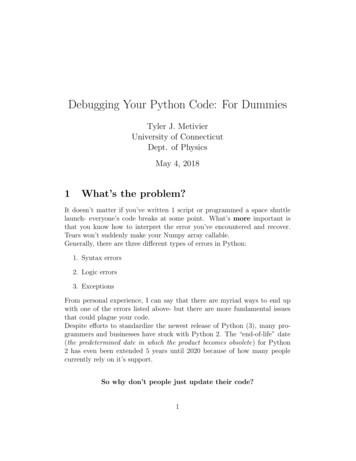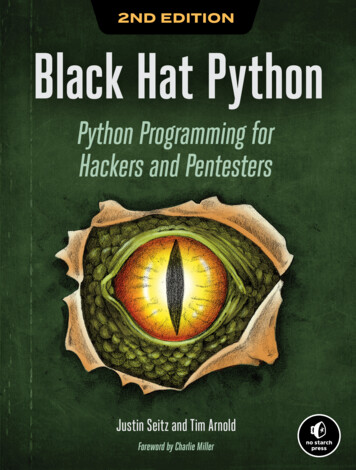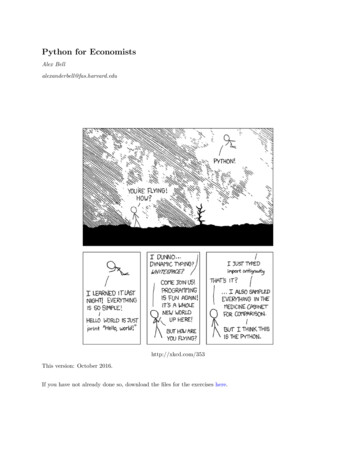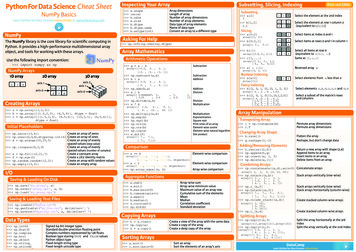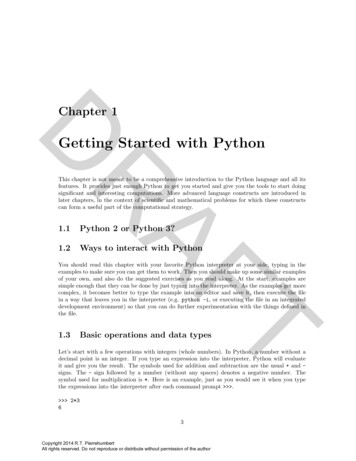
Transcription
Chapter 1DGetting Started with PythonAFRThis chapter is not meant to be a comprehensive introduction to the Python language and all itsfeatures. It provides just enough Python to get you started and give you the tools to start doingsignificant and interesting computations. More advanced language constructs are introduced inlater chapters, in the context of scientific and mathematical problems for which these constructscan form a useful part of the computational strategy.1.1Python 2 or Python 3?1.2Ways to interact with PythonYou should read this chapter with your favorite Python interpreter at your side, typing in theexamples to make sure you can get them to work. Then you should make up some similar examplesof your own, and also do the suggested exercises as you read along. At the start, examples aresimple enough that they can be done by just typing into the interpreter. As the examples get morecomplex, it becomes better to type the example into an editor and save it, then execute the filein a way that leaves you in the interpreter (e.g. python -i, or executing the file in an integrateddevelopment environment) so that you can do further experimentation with the things defined inthe file.T1.3Basic operations and data typesLet’s start with a few operations with integers (whole numbers). In Python, a number without adecimal point is an integer. If you type an expression into the interpreter, Python will evaluateit and give you the result. The symbols used for addition and subtraction are the usual and signs. The - sign followed by a number (without any spaces) denotes a negative number. Thesymbol used for multiplication is *. Here is an example, just as you would see it when you typethe expressions into the interpreter after each command prompt . 2*363Copyright 2014 R.T. PierrehumbertAll rights reserved. Do not reproduce or distribute without permission of the author
4 -1 2 120 15CHAPTER 1. GETTING STARTED WITH PYTHON2-3-1 31*2*3*4*51 2 3 4 5DIn the last two examples, it doesn’t matter in what order the computer carries out theoperations, since multiplication of integers is commutative (i.e. a b b a) as is addition(a b b a). In cases where the order of operations matters, you need to be aware of the rulesdictating the order in which operations are carried out. The operations are not done in sequentialleft-to-right order, but instead use rules of precedence. First all the multiplications are carriedout, then all the additions. If you want some other order of operations, you specify the order bygrouping terms with parentheses. The following example illustrates the general idea.AFR 2*3 17 1 2*37 2*(3 1)8We’ll introduce a few more rules of precedence as we introduce additional operators, but generallyspeaking it never hurts to group terms with parentheses, and you should do so if you are notabsolutely sure in what order the computer will carry out your operations.Python integers can have an arbitrary number of digits. No integer is too big, at least untilyou run out of memory on your computer. For example, we can find the product of the first 26integers as follows: *21*22*23*24*25*26403291461126605635584000000LTThe L at the end serves as a reminder that the result is a ”long” integer, which can have anarbitrary number of digits. All Python integers are treated as long (rather than fixed length)integers when they get long enough to need it. For the native integer data type, the distinctionbetween fixed-length and long integers is removed in Python 3.For integers, defining division is a bit tricker, since you can’t divide any two integers andalways get an integer back. Clearly, we want 4 divided by 2 to yield 2, but what should we do with5 divided by 2? The actual answer is 2.5, which is not an integer, but we get a very useful integerto integer operation if we round the result to the next lower integer to the actual result (in thiscase 2). Note that this definition has some unintuitive implications when we do an integer divideinto a negative number: the integer divide of -5 by 2 is -3, and not -2 as might have been thought.Python represents integer division of this sort with the operator //. Here are a few examples: 5//22Copyright 2014 R.T. PierrehumbertAll rights reserved. Do not reproduce or distribute without permission of the author
1.3. BASIC OPERATIONS AND DATA TYPES5 -5//2-3 5//-2-3 5 - 2*(5//2)1DThe third example here illustrates the property that if m and n are integers, then the remainderm (n//m) n is a positive integer in the sequence 0, 1, .(n 1). In mathematics, this kind ofremainder is represented by the expression n(modm), where ”mod” is short for ”modulo”. Pythonuses the symbol % for this operation, as in5%25%3-5%2AFR 1 2 1 0720%3The mod operator is a very convenient way to tell if an integer n is divisible by another integerm, since divisibility is equivalent to the statement that n(modm) (implemented as n%m in Python)is zero. Testing divisibility is often used in number theory, but beyond that, in writing programsone often wants to perform some operation (such as writing out a result) every m steps, and theeasiest way to do this is to keep some kind of counter and then do the required operation wheneverthe counter is divisible by m.Exponentiation is represented by the operator **, as in: on takes precedence over all the other arithmetic operators we have introduced so far.That includes the unary - operator, so that -1**2 evaluates to -1, since the order of operationssays first we exponentiate 1 and then we take its negative. If we wanted to square -1, we’d haveto write (-1)**2 instead. x 2 ; y 3 z x*x y*y z13TYou can store intermediate results in a named container using the assignment operator,which is the sign in Python. Once a result is stored, it can be used in other operations by namelater, and the contents of the container can be printed by simply typing the name of the container.Container names can be any text without spaces, so long as it doesn’t begin with a digit, and isnot one of the words reserved for Python commands or other elements of the Python languageitself. Python will warn you if you use one of these by accidents. Here are some examples.Here, we have also illustrated the fact that multiple Python statements can be put on a singleline, separated by a semicolon. Containers fulfill a role loosely similar to ”variables” in algebra,Copyright 2014 R.T. PierrehumbertAll rights reserved. Do not reproduce or distribute without permission of the author
6CHAPTER 1. GETTING STARTED WITH PYTHONin that they allow us to specify operations to be performed on some quantity whose value we maynot know. Really containers just define a new name for whatever is on the right hand side of the sign. As we start working with objects in Python other than simple numbers, it will becomenecessary to pay some attention to whether the container refers to a separate copy of the thingon the right hand side, or is referring directly to the very same object, though by an alternatename. The real power of containers will come later, when we introduce ways to define operationson containers whose values have not yet been assigned, and which will not be carried out until weplug in the values we want.DIn mathematics, expressions that increment a variable by either adding a quantity or multiplying by a quantity are so common that Python has shorthand assignment operators of the form and * . For example the assignment x 1 is equivalent to the assignment x x 1, and theassignment x * 2 is equivalent to the assignment x x*2. This works for all Python data typesfor which the respective operations are defined.AFRA great deal of mathematics, and probably most of physical science, is formulated in terms ofreal numbers, which characterize continuous quantities such as the length of a line or the mass of anobject. Almost all real numbers require an infinite number of digits in order to be specified exactly.Nothing infinite can fit in a computer, so computations are carried out with an approximation tothe reals known as floating point numbers (or floats for short). The floating point representation isbased on scientific notation, in which a decimal fraction (like 1.25) is followed by the power of tenby which it should be multiplied. Thus, we could write 12000.25 as 1.200025·104 , or .002 as 2·10 3 .In Python, the exponent is represented by the letter e immediately preceded by a decimal fractionor integer, and immediately followed by an integer exponent (with a minus sign as necessary; Aplus sign is allowed but not necessary). Further, you can write the number preceding the exponentwith the decimal point whereever you find convenient. Thus, 12000. could be written 1.2e4,12e3 or .12e5, as well as any number of other ways. If the exponent is zero, you can leaave itout, so 12. is the same number as 12e0 . Unlike Python integers, floating point numbers retainonly a finite number of digits. Although numbers (both integer and floating point) are by defaultgiven in the decimal system for the convenience of the user, inside the computer they are storedin binary form. When dealing with a decimal fraction that cannot be represented exactly by astring of binary digits short enough for the computer to handle, this introduces a small amount ofround-off error. There is also a maximum number of binary digits assigned to the exponent, whichlimits the largest and smallest floating point numbers that can be represented. The values of theselimits are specific to the kind of computer on which you are running Python. 15.5e10155000000000.0 15.5e301.55e 31TPython will treat a number as a float if it includes a decimal point, or if it includes anexponent specification (regardless of whether the preceding digits include a decimal point. Thus1., 1.0 , 1e20 and 1.e20 are all floats. In displaying the value of a float, by default Python writesit out as a decimal fraction without the exponent if the number of digits is not too big, but putsit in standardized scientific notation if the number would get too long. For example:This is just a matter of display. 12000 and 1.2e4 are the same number inside the computer andhandled identically. In Section 1.14 we will discuss how to control the way a number is displayed.The arithmetic operators , - , * ,** work just the way they do for integers, exceptthey now keep track of the decimal point. Floating point division is represented by / .Copyright 2014 R.T. PierrehumbertAll rights reserved. Do not reproduce or distribute without permission of the author
1.3. BASIC OPERATIONS AND DATA TYPES7 2.5e4*1.5 3.37503.0 1./3.0.3333333333333333 3.*0.333333333333333331.0Division has equal precedence with multiplication, so in a term involving a sequence of* and / operations, the result is evaluated left-to-right unless a different order is specified withparentheses:D 2.*3./4.*5.7.5 2.*3./(4.*5.)0.3AFRThis can easily lead to unintended consequences, so it is usually best to be on the safe side andenclose numerator and denominator expressions in parentheses. The same remark applies to integerdivision // .Though the modulo operator is conventionally defined just for integers in number theory,in Python, it is also defined for floats. An expression like x%y will subtract enough multiples of yfrom the value x to bring the result into the interval extending from zero to y. This can be veryuseful for periodic domains, where, for example, the point x nL is physically identical to thepoint x for any integer n.Exponentiationcan be carried out with negative or fractional exponents, e.g. 2.**.5 is the same as 2 and 2.**-1 is the same as 1./2. Negative floats can be raised to an integerpower, but if we try to raise a negative float to a non-integer power Python responds with an errormessage:T (-1.5)**3-3.375 (-1.5)**3.0-3.375 (-1.5)**-3-0.2962962962962963 (-1.5)**3.1Traceback (most recent call last):File " stdin ", line 1, in module ValueError: negative number cannot be raised to a fractional powerThis is because the result of raising a negative number to a fractional power is not a real number.We’ll see shortly that this operation is perfectly well defined if we broaden our horizon to includecomplex numbers, but Python does not do complex arithmetic unless it is explicitly told to do so.Note that, as shown by the second example, Python knows when a number written as a float hasan integer value, and acts accordingly.In any operation involving two different types, all operands are promoted to the ”highest”type before doing the operation, with a float being considered a higher type than an integer. Thus,the expression 1 1.5 yields the float result 2.5. The exponentiation operator also promotesCopyright 2014 R.T. PierrehumbertAll rights reserved. Do not reproduce or distribute without permission of the author
8CHAPTER 1. GETTING STARTED WITH PYTHONoperands to float when using negative exponents, even if everything is an integer. Thus 2**-2evaluates to 0.25 but 2**2 yields the integer 4.DWhat do you do if you want to divide two integers and have the result come out like afloating point divide? One way to do that is to just put a decimal point after at least one ofthe integers so that Python treats the division as floating point – you only really need to do thisto one thing in the numerator or denominator, since everything else will be promoted to a floatautomatically. Thus, 1./2 or 1/2. will both evaluate to .5. But suppose you have two variablesa and b which might contain integers, but you want the floating-point quotient of them? One wayto do that is to force a conversion to a float by multiplying either the numerator or denominatorby 1. There are other ways to do a type conversion, which you’ll learn about shortly, but thiswill do for now. Then if a 1 and b 2 we get the desired result by typing (1.*a)/b. It is a bitsilly to have to do this to force a float division when we would generally use // if we really wantedinteger division, but in Python 2.x this is indeed what you need to do. It will still work in Python3, but Python 3 made the sensible division to always treat a/b as float division even if a and b areintegers.AFR Python has complex numbers as a native (i.e. built-in) data type. The symbol j is usednumberfor 1, and the imaginary part of a complex constant is given by a floating point immediatedly followed by j, without any spaces. Note that even if you want to represent 1 byitself, you still need to write it as 1j, since an unadorned j would be interpreted as a reference toa container named j. Here are some examples of the use of complex arithmetic: z1 7.5 3.1j ; z2 7.5-3.1j z1 z2(15 0j) z1*z2(65.86 0j) z1**.5(2.7942277489593965 0.5547149836219465j) (-1 0j)**.5(6.123233995736766e-17 1j)It often happens that you need to create a complex number out of two floats that have previouslybeen stored in containers. Here is one way you can do this:T x 1.;y 2. z x y*1j z(1 2j)Note that simply writing z x yj will not work, since Python will try to interpret yj as the nameof a container.In the promotion hierarchy, complex is a higher type than float, so operations mixingcomplex and tt float values will yield a complex result. The final example above comes out alittle bit differently from the exact answer 0 1j because of the finite precision of computerarithmetic. Depending on the precision of the computer you are using, the answer you get maydiffer slightly from the example.This example also illustrates how Python guesses whether you wishan operation to be carried out using complex or real arithmetic – if there is any complex numberinvolved, the whole operation is treated as complex. If you instead tried (-1.)**.5 you would getCopyright 2014 R.T. PierrehumbertAll rights reserved. Do not reproduce or distribute without permission of the author
1.3. BASIC OPERATIONS AND DATA TYPES9an error message, since it would be assumed the operation is meant to be carried out over the realnumbers. Try evaluating (-1.)**1j, and check the answer against the expected result (which youcan determine using the identity eiπ 1). Also try evaluating (-1.)**3., (-1. 0j)**3.1 and(-1.)**3.1. Why do the first two work, whereas the last causes an error message?The real and imaginary parts of native Python complex numbers are always interpreted asfloats whether or not you include a decimal point. Complex integers (known to mathematiciansas Gaussian integers) are not a native data type in Python, though in Chapter ? you will learnhow to define new data types of your own, including Gaussian integers.DPython also allows Boolean constants, which can take on only the values True or False.Various logical operations can be carried out on Boolean expressions, the most common of whichare and, or and not. Here are a few examples of the use of Boolean expressions.AFR ToBe True ToBe or (not ToBe)True ToBe and (not ToBe)FalseWhen applied to Boolean data, the ampersand (&) is a synonym for the keyword and, and thevertical bar ( ) is a synonym for or.Boolean expressions will prove useful when we need to make a script do one thing if someconditions are met, but other things if different conditions are met. They are also useful forselecting out subsets of data contingent on certain conditions being satisfied. Relational operatorsevaluate to Boolean constants, for example 1 2True 1 2False 1 2FalseNote the use of the operator to test if two things are equal, as distinct from which representsassignment of a value to a container. The compound relational operators are (”Greater thanor equal to”) and (”Less than or equal to). Since relational expressions evaluate to Booleanvalues, they can be combined using Boolean operators, as inwhich evaluates to TrueT (1 2) or not (6%5 0)The final basic data type we will cover is the string. A string consists of a sequence ofcharacters enclosed in quotes. You can use either single quotees (’ or double quotes (") to definea string, so long as you start and end with the same kind of quote; it makes no difference toPython which you use. Strings are useful for processing text. For strings, the operator results inconcatenation when used between two strings, and the * operator results in repetition when usedwith a string and a positive integer. Here are some examples: hobbit1 ’Frodo’; hobbit2 ’Bilbo’Copyright 2014 R.T. PierrehumbertAll rights reserved. Do not reproduce or distribute without permission of the author
10CHAPTER 1. GETTING STARTED WITH PYTHON hobbit1 ’ ’ hobbit2’Frodo Bilbo’ hobbit1 2*hobbit2’FrodoBilboBilbo’This is a good example of the way operations can mean different things according to what kindof object they are dealing with. Python also defines the relational operator in for strongs. If s1and s2 are strings, then s1 in s2 returns True if the string s1 appears as a substring in s2, andFalse otherwise. For example:D crowd ’Frodo’True ’Bilbo’False ’Bilbo’True’Frodo Gandalf Samwise’in crowdin crowdnot in crowdAFRThe relational operators , and are also defined for strings, and are interpreted in terms ofalphabetical ordering.In some computer languages, called typed languages, the names of containers must be declared before they are used, and the kind of thing they are meant to contain (e.g. float, int, etc.) must be specified at the time of declaration. Python is far more free-wheeling: a container iscreated automatically whenever it is first used, and always takes on the type of whatever kind ofthing has most recently been stored in it, as illustrated in the following: 6.0 ’Wex 2. ; y 4.x yx "We were floats,"; y " but now we are strings!"x ywere floats, but now we are strings!’1.4TPython’s let-it-be approach to containers is very powerful, as it makes it possible to easily writecommands that can deal with a wide variety of different types of inputs. This puts a lot of powerin the hands of the user, but with this power comes a lot of responsibility, since Python itself isn’tcontinually looking over your shoulder checking whether the type of thing put into a container isappropriate for the intended use. A well designed command (as we shall learn to write) shouldalways do whatever checking of types is necessary to ensure a sensible result, though Python doesnot enforce this discipline.A first look at objects and functionsEverything in Python is an object. Objects in the computer world are much like objects in thephysical world. They have parts, and can perform various actions. Some of the parts (like thepistons in an automotive engine) are meant to be the concern of the designer of the object onlyand are normally hidden from the user. Others (like the steering wheel of a car) are meant toCopyright 2014 R.T. PierrehumbertAll rights reserved. Do not reproduce or distribute without permission of the author
1.4. A FIRST LOOK AT OBJECTS AND FUNCTIONS11interface with other objects (the driver) and cause the object to carry out its various purposes.Complex objects can be built from simpler objects, and one of the prime tenets in the art ofobject-oriented programming is to design objects that are versatile and interchangeable, so theycan be put together in many ways without requiring major re-engineering of the components.DThe parts of an object are called attributes. Attributes can be data, or they can be thingsthat carry out operations, in which case they are called methods. in fact, the attributes of anobject can be any object at all. In this section you will get a glimpse of how to use objects thatsomebody else has created for you. Later in this chapter you’ll learn the basics needed to craft yourown custom-designed objects, and later chapters will develop more facility with objects, throughcase-studies of how they can be used to solve problems.The attributes of an object are indicated by appending the name of the attribute to the nameof the object, separated by a period. For example, an object called shirt can have an attributecalled color, which would be indicated by shirt.color. Since attributes can themselves beobjects, this syntax can be nested to as many levels as needed. For example, if an object calledoutfit has shirt as an attribute, then the color of that shirt is outfit.shirt.color.AFRAs an example, let’s consider the complex number object z which is created for you whenyou write z 1 2j. This has two data attributes, which give the real and imaginary parts asshown in the following example: z.real1.0 z.imag2.0 z.real**2 z.imag**25.0The last command in this example illustrates the fact that you can use attributes in any Pythonexpression for which any other objects of their type (floats, in this case) can be used.When an attribute is a method rather than simple data, then typing its name only givesyou some information on the method. In order to get the method to actually do something, youneed to follow its name with a pair of matched parentheses, (). For example, a complex numberobject has a method called conjugate, which computes the complex conjugate of the number asillustrated in the following exampleT z.conjugate built-in method conjugate of complex object at 0x2c3590 z.conjugate()(1-2j) z*z.conjugate()(5 0j) (z*z.conjugate()).real5.0In this example, the conjugate method returns a value, which is itself a complex number, thoughin general methods can return any kind of object. Some methods do not return anything at all,but only change the internal state of their object, e.g the values of the attributes. The final partof the example shows that you can get an attribute of an object without assigning a name to theobject.Copyright 2014 R.T. PierrehumbertAll rights reserved. Do not reproduce or distribute without permission of the author
12CHAPTER 1. GETTING STARTED WITH PYTHONMany methods require additional information in order to carry out their action. The additional information is passed to the method by putting it inside the parentheses, and takes the formof one or more objects placed within the parentheses, separated by commas if there are more thanone. These items are called arguments, following the mathematical terminology in which one refersto an argument of a function. The type of object that can be passed as an argument depends onwhat the method expects, and a well-designed method will complain (by giving an error message)if you hand it an argument of a type it doesn’t know how to handle.DFor example, string objects have a method upper which takes no arguments and returnsan all-capitalized form of the string. They also have a method count which takes a string asits argument and returns an integer giving the number of times that string occurs in string towhich the method belongs. The replace method takes two strings as arguments, and replaces alloccurrences of the first argument with the second. For example, if s ’Frodo Bilbo Gandalf’,thenAFR s.upper()’FRODO BILBO GANDALF’ s’Frodo Bilbo Gandalf’ s.count(’o’)3 s.count(’Gan’)1 s.replace(’Bilbo’,’Samwise’)’Frodo Samwise Gandalf’Note that in in the upper and replace examples, the original string is left unchanged, while themethod returns the transformed string.Some arguments are optional, and take on default values if they are not explicitly specified.For example, the strip method of a string object, by default, strips off leading and trailing blanksif it is not given any arguments. However, if you can optionally give it a string containing thecharacters you want to strip off. Here’s an example of how that works if s ’ ---Frodo--- ’: s.strip()’---Frodo---’ s.strip(’- ’)’Frodo’TCausing a method to do something is known as invoking the method, rather like invoking ademon by calling its name. This is also referred to as calling the method. Objects can themselvesbe callable, in which case one calls them by putting the parentheses right after the object name,without the need to refer to any of the object’s methods.In computer science, a callable object is often referred to as a function, because one ofthe things a callable object can do is define a mapping between an input (the argument list)and an output (the value or object returned by the function). This is pretty much the waymathematicians define functions. However, functions in a computer language are not preciselyanalogous to functions in mathematics, since in addition to defining a mapping, they can changethe internal state of an object, or even change the state of objects contained in the argument list.Because of the generality of what they can do, functions in Python need not return a value, andfor that matter need not have any argument list within the parentheses.Copyright 2014 R.T. PierrehumbertAll rights reserved. Do not reproduce or distribute without permission of the author
1.4. A FIRST LOOK AT OBJECTS AND FUNCTIONS13Nonetheless, many functions in Python do behave very much like their counterparts inmathematics. For example, the function abs implements the mathematical function which returnsthe absolute value of an argument x, namely x . Just as in mathematics, the definition of thefunction depends on the type of argument, the allowable types being real (called float in Python)and complex.pFor a complex argment z with real part x and imaginary part y, the absolute valueis defined as x2 y 2 , whereas for a real argument, the absolute value of x returns x itself if x 0and x if x 0. A well behaved computer function checks for the type of its argument list andbehaves accordingly; it also makes sure the number of arguments is appropriate.AFRD abs(-1.)1.0 abs(1 1j)1.4142135623730951 abs(1,2)Traceback (most recent call last):File " stdin ", line 1, in module TypeError: abs() takes exactly one argument (2 given)Python includes a small number of predefined functions (like abs) which are available assoon as the interpreter is started. Many of these convert data items from one type to another.For example, the function int converts its argument to an integer. If the argument is a float,the conversion is done by truncating the number after the decimal point. Thus, int(2.1) returnsthe integer 2, and int(-2.1) returns the integer -2. Similarly, the function float converts itsargument to a float. The function complex, when called with two integer or float arguments,returns a complex number whose real part is the first argument and whose imaginary part is thesecond argument. This function provides a further indication of the versatility of Python functions,as the function examines its argument list and acts accordingly: you don’t need a different functionto convert pair of int data types vs. a pair of float data types, or even one of each. For thatmatter, if complex is called with just a single argument, it produces a complex number whose realpart is the float of the sole argument and whose imaginary part is zero. Thus, complex(1,0)and complex(1.) both return the complex number 1. 0.j. The ability to deal with a varietyof different arguments goes even further than this, since the type conversion functions can evenconvert a string into the corresponding numerical value, as illustrated in the following example:T x ’1.7 ’;y ’ 1.e-3’ x y’1.71.e-3’ float(x) float(y)1.7009999999999998(note the effect of roundoff error when the addition is performed). This kind of conversion is veryuseful when reading in data from a text file, which is always read in as a set of strings, and must beconverted before arithmetical manipulations can be performed. Going the other way, when writingout results to a text file, it is useful to be able to convert numerical values to strings.
limits are speci c to the kind of computer on which you are running Python. Python will treat a number as a oat if it includes a decimal point, or if it includes an exponent speci cation (regardless of whether the preceding digits include a decimal point. Thus 1., 1.0 ,






